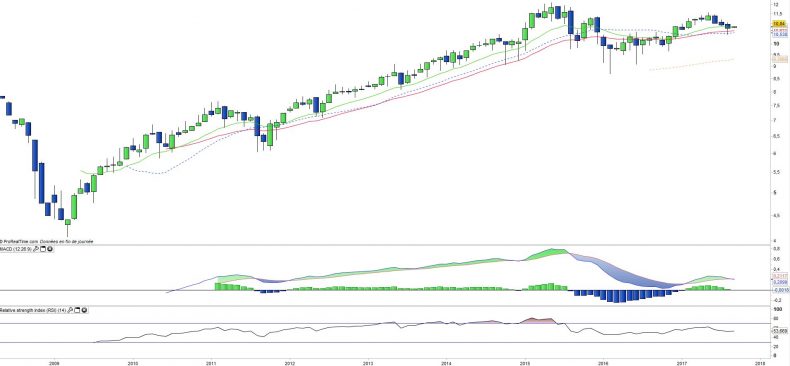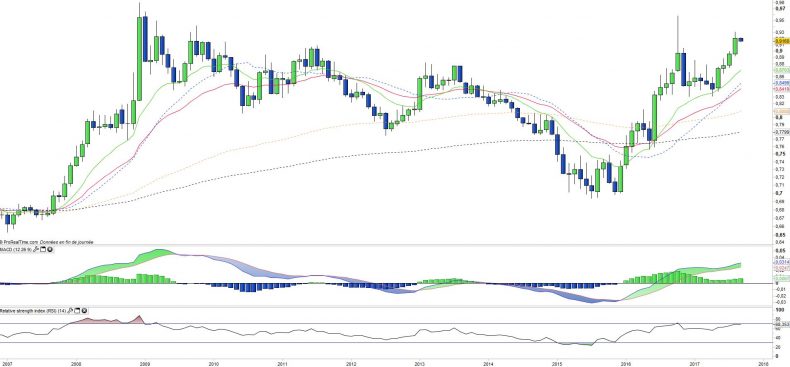Lyxor ETF FTSE 100 (L100) - 04/09/2017
Short term strategy : Negative (20%) / Trend =
Long term strategy : Positive (60%) / Trend -
Characteristics of the ETF
The ETF L100 (Lyxor) replicates the FTSE 100 index, which is composed of the top 100 English stocks that are representative of the main sectors of the UK economy, and which are selected based on the size of their market capitalization.
The index is quite deep, and above all fairly balanced from a sectoral point of view. However, we note the specificity of a significant weighting in the raw materials sector, as the oil & gas + mining sector represents almost 24% of the index (compared to only 6% for the stoxx600), almost as much as the financials and consumer goods. The health sector is also very important and represents 10% of the index. All this implies that the FTSE 100 is very "dollarized" because the income of these companies is usually largely realized in the US currency, which is not insignificant either given the current weakness of the USD against the Euro. The FTSE 100 is of course quoted in Sterling, so there is a particular exposure to the british currency on the L100 ETF which quotes in euros, therefore leading to a decorrelation from the FTSE100 index for a few weeks.
If the ‘Brexit’ failed to translate into a financial crisis, it must be said that the shock was mainly passed on the British Pound which has since declined by about 20% against the Euro and while the FTSE 100 rose by 14% in 2016 and by about 5% in 2017 (against 0% for the L100 ETF). The effective exit of the United Kingdom, the 6th world largest economy, is expected to occur in early 2019, while the trigger of Article 5 was achieved as planned in March 2017. Its impact should be felt in the long run because it will probably require an adaptation of the English model. But the political weakness of Mrs May, who no longer has a majority in parliament, after the debacle of last 8 June, could ultimately favor a “soft brexit”. An extension of the negotiation period (with the preservation of the status quo) by another 2 years is also not to be excluded, especially if the negotiations are moving towards an agreement, which is not the case at present. Europe is for the moment united against England, and is firm in its requirements, while threats of dislocation from the United Kingdom are beginning to appear (the reunification of Ireland under the European flag and the Scottish referendum). On the other hand, the short-term good news of English exporters benefitting from the weak pound to gain market shares, may have negative counterparts, such as inflation surge and rising interest rates.
The Pound has declined by about 10% against the Euro since May 2017 and continues to be the main vehicle for bad news – difficult negotiations with Europe - returning almost to the lowest level of 2016 post-brexit and is approaching parity.
For the moment the English index is very resilient (+ 4.5% since the beginning of the year) in line with the Eurostoxx50 and benefits from the recent rise in raw materials. However, the rapid deterioration in household purchasing power is disturbing: in Q217 household spending increased by only 0.1%, their slowest growth since the end of 2014, due to the fall of the pound, while the decline in industrial investment is expected to continue to weigh on growth expected at around 1.7% in 2017 and only 1.5% in 2018. Unemployment, at the lowest level since 1975, reached 4.4% in August and the good performance of manufacturing activity (PMI higher than expectations in August) boosted by exports, remain strong assets for the British economy which should not collapse, especially if global economic growth remains as robust as expected.
L100 has AUM of €666 million and charges a fee of 15 basis points a year.
Monthly data
The analysis of the L100 monthly charts shows a long - term upward trend which has been dwindling for a few months, this corresponds to the English elections and essentially reflects the decline in the British currency and the Dollar against the Euro. A disturbing technical element is the weakening of the MACD, which threatens to turn down.
The graph has flattened out over the last several months, which could lead to a prolonged non-directional phase.
Monthly data
It is interesting to put in perspective the EUR / GBP pair which is a key element for the ETF L100 as well as the EUR / USD. We can see on the chart that the Euro/GPB few months consolidation between Q416 and Q117 was only a technical pull back, and that the upward trend of the euro resumed momentum and is approaching the long-term resistance of 0.95.
If this resistance were to be overcome, a long-term appreciation of the EUR would be validated, with the objective of parity with the British currency under reach, a symbol with a strong psychological implication.
ETF Objective
L100 is a UCITS compliant ETF that aims to track the benchmark index FTSE 100 TR (market-capitalisation weighted index representing the performance of the 100 largest UK-domiciled blue chip companies)
Characteristics
| Inception date | 03/04/2007 |
| Expenses | 0,15% |
| Benchmark | FTSE 100 - UKX |
| Code / Ticker | L100 |
| ISIN | FR0010438127 |
| UCITS | Yes |
| EU-SD Status | Out of scope |
| Issuer | Lyxor |
| Currency | € |
| Exchange | Euronext Paris |
| Assets Under Management | 666 M€ |
| PEA | No |
| SRD | Yes |
| Dividend | Capitalisation |
| Currency risk | Yes |
| Number of Holdings | 100 |
| Risk | 3/5 |
Country Breakdown
| United Kingdom | 79% |
| Netherlands | 9% |
| Ireland | 5% |
| Switzerland | 3% |
| Australia | 2% |
| Others | 2% |
Sector Breakdown
| Financials | 19% |
| Consumer Staples | 18% |
| Energy | 14% |
| Consumer discretionary | 11% |
| Health Care | 10% |
| Materials | 10% |
| Industrials | 8% |
| Others | 10% |
Top Ten Holdings
| Royal Dutch Shell | 9% |
| HSBC Holdings | 8% |
| British American Tobacco | 6% |
| BP | 5% |
| GlaxoSmithKline | 4% |
| AstraZeneca | 3% |
| Vodafone Group | 3% |
| Diageo | 3% |
| Unilever | 3% |


